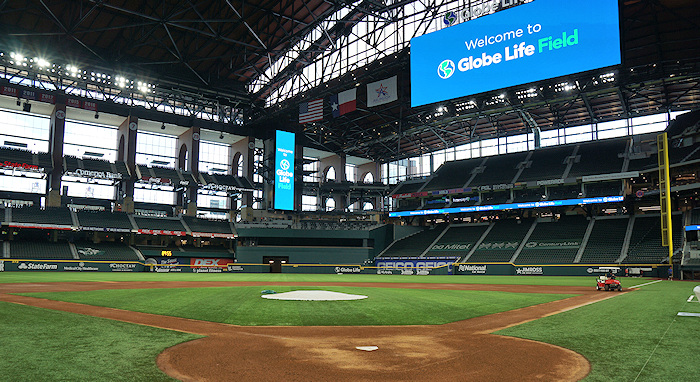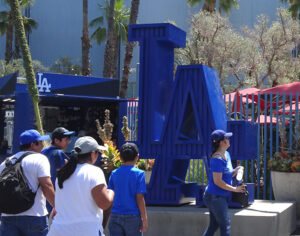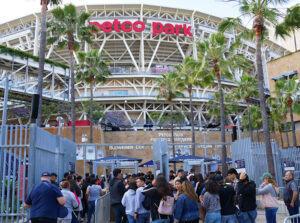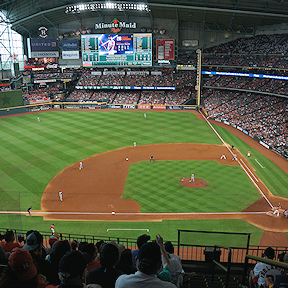
This article, originally prepared for USA TODAY Sports Weekly, explains why MLB chose to format the 2020 playoffs differently than in past years.
by JOE MOCK
All rights reserved
ARLINGTON, TEXAS Heading into the 2020 season, fans of the Texas Rangers had high hopes of seeing the team’s brand-new ballpark host the World Series. Globe Life Field will indeed be the site of the Fall Classic when it begins October 20, but the Rangers aren’t invited.
Fans in the Lonestar State never envisioned that the Series could be played in Arlington without the hometown Rangers as the American League representative, but that’s what is happening because the Rangers didn’t qualify for the playoffs.
Just one more crazy occurrence in a year unlike any other.
“The best way to say it is that 2020 presented some really, really difficult challenges for the sport,” Commissioner Rob Manfred told USA TODAY Sports. Even that is somewhat of an understatement.
While not the “bubble” arrangement utilized by the NBA and WNBA where all games are played in a single location (the NHL utilized two), MLB’s 60-game regular season was held at the 30 teams’ parks. This included Buffalo’s Sahlen Field after the Blue Jays were barred from playing in Toronto. The COVID-19 pandemic necessitated significant protocols for the “health and safety” of the players and staffs, and travel was restricted to markets in each team’s division plus the corresponding division in the other league.
And quite significantly, no fans were allowed to attend.
Now the playoffs are moving ahead with a set of unprecedented arrangements, all due to the virus. Perhaps the most succinct description of the scenario devised for the postseason is Bubble Baseball.
Within each round of the playoffs, there will be no movement of the teams. The park in which they play Game 1 will host all of that series’ games. With 16 teams making the postseason, that means eight matchups in the best-of-three Wild Card round. The games are being held in the home parks of the four clubs with the highest seeding in each league.
MLB’s Chief Operations and Strategy Officer Chris Marinak admits that there is a “lower bar” for making the playoffs this year as a result of the shorter regular season. Allowing the higher-seeded team to play the full series at home, though, provides a “meaningful advantage over the teams that didn’t perform as well.” As things turned out, the Twins, Cubs and Indians didn’t find the advantage all that meaningful, as they were all higher-seeded teams who were swept at home in the Wild Card round.
Here come the bubbles
The eight teams that survived the first round paired off in the best-of-five Divisional Series. The two American League matchups began play on October 5, with the two in the National League kicking off the following day.
 Here, though, no team is playing in its home park, as the “bubbles” for the American League are at National League parks – Dodger Stadium in Los Angeles and Petco Park in San Diego. The two NLDS clashes are at Minute Maid Park in Houston and Globe Life Field in Arlington, both AL markets. Again, there’s no travel once each series begins.
Here, though, no team is playing in its home park, as the “bubbles” for the American League are at National League parks – Dodger Stadium in Los Angeles and Petco Park in San Diego. The two NLDS clashes are at Minute Maid Park in Houston and Globe Life Field in Arlington, both AL markets. Again, there’s no travel once each series begins.
To control the spread of the virus during the regular season, MLB learned that “it requires that you take it extremely seriously and prioritize health and safety over the course of playing a game,” explains Marinak. “What we’re thinking about in the postseason is that there’s really no way to keep the virus out if you’re running a normal format” where both teams in a series host home games.
Having two teams remain in the same city for the duration of a series “is a much more controlled environment. I think the risk is dramatically lower in the postseason the way we’ve structured it.”
The success of the arrangements utilized by the NBA and NHL this summer were quite valuable in MLB’s decision making. “They have both shown that once you create a closed environment, you really can keep the virus out,” says Marinak.
 The winning teams in San Diego and Los Angeles will play the best-of-seven ALCS at Petco Park starting October 11. The NLDS victors in Houston and Arlington will face off in the NLCS at Globe Life Field beginning the following day. The pennant winners will clash in the 116th World Series starting on October 20. If it goes the full seven games – all in Arlington — the deciding contest will be October 28.
The winning teams in San Diego and Los Angeles will play the best-of-seven ALCS at Petco Park starting October 11. The NLDS victors in Houston and Arlington will face off in the NLCS at Globe Life Field beginning the following day. The pennant winners will clash in the 116th World Series starting on October 20. If it goes the full seven games – all in Arlington — the deciding contest will be October 28.
And as you might’ve guessed, this is the first time in history that the World Series is being played at a neutral site. Even when a 6.9 magnitude earthquake rocked the Bay Area minutes before Game 3 of the 1989 Fall Classic between the Giants and A’s, the Series wasn’t moved elsewhere. Instead, MLB waited until it was safe to play in the Bay Area. After a 10-day delay, Game 3 was finally played at Candlestick Park in San Francisco, just as it was originally scheduled to be.
Regarding the dates of the 2020 playoffs, Marinak says “We feel it’s really important to get our postseason played in October.” MLB has taken flak when the World Series has wrapped up in early November, as it did in 2001 when the schedule was pushed back due to 9/11. That year, Game 7 was November 4.
The chosen cities
MLB employed three criteria in selecting the cities for the bubbles for the final three rounds of the postseason.
 Weather was the first consideration, because rainy or freezing conditions can affect “the product on the field,” says Marinak. And in the case of Houston and Arlington, even a deluge won’t hinder the games because of the retractable roofs at the two parks.
Weather was the first consideration, because rainy or freezing conditions can affect “the product on the field,” says Marinak. And in the case of Houston and Arlington, even a deluge won’t hinder the games because of the retractable roofs at the two parks.
Second, they wanted the venues to be a “bus-ride distance” from each other, as Los Angeles is from San Diego and Arlington is from Houston. This eliminates the risk of virus spread on airplanes, “although we will have to charter a plane from San Diego to Arlington to get the AL winner to the World Series,” he admits.
Third, you probably could have guessed that television would play a role in the selection of markets. Marinak explains that it’s helpful to have the games in the Central or Pacific Time Zones to provide “gametime flexibility to create optimal TV windows. You’re not going to play a game on the East Coast at 10:30 local time.”
He also shed light on why certain dates were chosen for the playoff games – including why there are “travel days” in the middle of the World Series when there won’t be any travel (again, television). “One of the big things is trying to get the games into the right windows for the broadcasts.” MLB worked with the networks to avoid certain dates and days of the week when, say, a Presidential Debate is scheduled, or there are other programming conflicts.
As for the off days during the Fall Classic following Games 2 and 5, Marinak notes that “there will be a lot of storylines and media elements to cover, so we felt like it would be a good to have a break in the action to get a chance for the players to do some media and to regroup.” There are no off days in the series prior to the Fall Classic, though.
Let’s look at the logistics for a specific team. The Dodgers are the #1 seed in the National League, and they played Milwaukee, the #8 seed, in their Wild Card Series. That meant the best-of-three series was in LA. Since the favored Dodgers dispatched the Brewers in two games, they then moved on to Arlington, where they would stay put through the NLDS, NLCS and Fall Classic — provided they keep winning. It’s nice to finish first.
Another advantage of having the higher seed is that the teams get to occupy the home team’s clubhouses at the four Bubble ballparks. If you’ve ever gone on a tour of these stadiums, you’ve noticed how much nicer – including phenomenal training and workout areas (especial in Arlington) – the home facilities are.
But even though the higher-seeded team gets the home clubhouse, that doesn’t mean that they get to bat last in all of the series’ games. MLB is employing a familiar arrangement, even though the same sites will be used throughout the LDS, LCS and World Series. In the best-of-five LDS, the higher seeded team will play as the “home” team in games 1, 2 and 5, just as if the teams were moving back and forth between cities. In the LCS and Fall Classic, the higher-seeded teams will be “home” in Games 1, 2, 6 and 7.
You reap what you sow
Is it possible for a team with a better record to have a lower seed than a squad with a worse record? Absolutely … so let’s look at why the 16 teams in the postseason are seeded the way they are.
The top seed in each league is the team with the best record – the Rays in the AL and the Dodgers in the NL. The #2 and #3 seeds are the other two division winners regardless of their records – the A’s and Twins in the AL and in the NL, the Braves and Cubs. However, the second-place finisher in the NL West, the Padres, won 37 games, two more than the Braves and three more than the Cubs, yet San Diego is a lower seed (#4).
That’s because records tell only part of the story. MLB felt that even with a shortened schedule this year, “we still had a very important regular season,” says Marinak. They wanted to reward the teams that claimed their division crowns, even if they had a worse record than a second-place club in another division. In this respect, MLB did this differently than the NHL, which just ranked records in each conference to determine its playoff seeding.
So the three division winners in each league are the top three seeds, while the three second place teams make up the #4, #5 and #6 seeds, in order of record. MLB refers to these as “playoff berth winners.” In the AL, these teams are the Indians, Yankees and Astros, so these are the #4, #5 and #6 seeds. In the NL, the teams capturing these “berths” are the Padres, Marlins and Cards.
Then the two clubs in each league with the best records that didn’t finish either first or second, are designated as Wild Card teams, so they are the #7 and #8 seeds. In the AL, that’s the White Sox and Blue Jays. Interestingly in the NL, both of the Wild Card teams are from the same division – the Reds and Brewers. So, yes, a team that finished fourth in its division (Milwaukee) qualified for the postseason. They were the only NL team with a losing record to make the playoffs.
So that’s how the seeding was done. By the way, the teams are not re-seeded after each round. Your seeding stays with you throughout your run. This means that if a #8 seed knocks off the #1 seed in the Wild Card round, that winning team is still the bottom seed in its league all the way through the postseason. But, hey, at least they still made the playoffs even though they had a losing record.
Speaking of such things, note that the Astros – deservedly castigated during the offseason for their systemic cheating in 2017 and 2018 – had a losing record this year. Karma, anyone? Of course, because they finished second in the AL West, they still made the playoffs – and were the only AL team with a sub-.500 record to make the postseason. And as a #6 seed because they finished second in their division, they had a worse record than the #7 and #8 Wild Card clubs.
So in each round, the higher-seeded team gets the home clubhouse and is the home team on the scoreboard for the early and late games in the series. But what happens when we get to the World Series? Say, the two combatants were both the #2 seeds or both the #3 seeds in their leagues, who gets the “home” designation then? In this instance, the team with the higher winning percentage during the regular season gets the nod.
And in case you’re curious, the designated hitter will be used in all postseason games, but an “automatic runner” will be not be placed at second base in extra innings. The latter rule was just for the regular season, to keep pitching staffs from being depleted in games that dragged on inning after inning.
So with 16 teams playing in the Wild Card round, that means more than half of MLB’s 30 teams made the playoffs. As a broadcaster friend of mine quipped sarcastically, “What happens to the rest of the teams? Do they get to play in the NIT?”
What about fans?
After a regular season where no fans were allowed to attend any games, that won’t be the case for some postseason contests. “One of the most important things to our game is the presence of fans,” admits Manfred. That’s why “we are pressing ahead to have fans in Texas.”
“Given what we’ve heard from the (Texas) governor and local officials, I think they feel good about it,” Marinak said before the start of the postseason. “If we can also feel good about it, and pull it off in a safe way, it’s something we’ll pursue.”
Marinak acknowledged that restrictions in California will prevent any fans at contests in San Diego and Los Angeles, but it will be a different story at Globe Life Field. He said MLB examined the ways fans enter and exit the parks, the spacing in the seats and how to avoid crowds at concession stands. After working with architects and stadium operators to devise ways to pull this off, they announced on September 30 that tickets will be sold for the NLCS and World Series in Arlington.
There will be no in-person sale of tickets. Online sales will begin at 10:00 am on October 6 for both the NLCS and World Series. There will be no paper tickets (everything must be digital on fans’ phones), and capacity will be capped at 11,500 per game.
Life in the bubble
Life for the players during the playoffs will be much like their roadtrips during this season – frequent COVID tests and the requirement to remain within the confines of their hotels.
However, the accommodations will be nicer. “We’ve gone out of our way to put the players in resort style hotels that are more secluded with lots of outdoor space,” Marinak explains. Another lesson learned from the NBA and NHL is the need to “re-create as many of the traditional elements of the real world as you can in these environments – eating options, entertainment, spaces where people can get together while still maintaining (a safe) distance.
“We spent quite a lot of time and energy on amenities for the players, for the staff, for the families, so that they feel like this is as normal as possible, recognizing that nothing in 2020 is quote-unquote normal.”
Perhaps the biggest difference for players from the regular season, though, is the ability to have their family stay with them. For players who want this, they and their families have been going through quarantine measures prior to the playoffs. They will then be able to stay together in the designated hotels, but won’t be allowed to leave what MLB refers to as “the secure zone” or have any interactions with those who haven’t gone through the quarantine protocols. This is a move many players have been requesting.
The umpires in the postseason also seem to be happy with the measures MLB has undertaken. In a statement provided to USA TODAY Sports, the MLB Umpires Association said “The season and playoffs should not be about the umpires. The focus should remain on the teams and players. The MLBUA is happy for all MLB has done to make our work environment safe and secure.”
Arlington is a happy place
While the players and umps are satisfied about the postseason arrangements, those in Arlington are positively ecstatic.
Arlington’s mayor, Jeff Williams, said “To think about the opportunity to be having (the) baseball playoffs and the World Series here in our community, we get extremely excited.”
Adds Rob Matwick, the Rangers’ Executive VP of Business Operations, “The eyes of the nation, the eyes of the world will be on Arlington and Globe Life Field for the 116th World Series. We (have) the newest and we think the best ballpark in Major League Baseball, so we are looking forward to that opportunity to show it off.”
Arlington also boasts a beautiful, new hotel adjacent to Globe Life Field. Live! By Loews is part of the Texas Live! entertainment district built on the northern edge of the Rangers’ new park. Players won’t be staying there, but “we’re going to use that hotel for staff, broadcast personnel and families (of players) that choose not to quarantine,” explains Marinak. “That entire hotel will be utilized, and it’s a great facility.”
The staff at the Loews Hotel is pleased to welcome the group. “Our hotel is a true sports resort in the heart of Arlington’s Entertainment District. Guests, visitors, and neighbors are treated to our laid-back luxury experiences while being steps away from two iconic sports venues, Globe Life Field and AT&T Stadium,” said Scott Nassar, the Managing Director at Live! By Loews.
You can’t blame the folks in Arlington, though, if they hope the 117th World Series comes back to Globe Life Field, this time with the Rangers playing for the Commissioner’s Trophy.
Mock covers sports facilities for USA TODAY publications